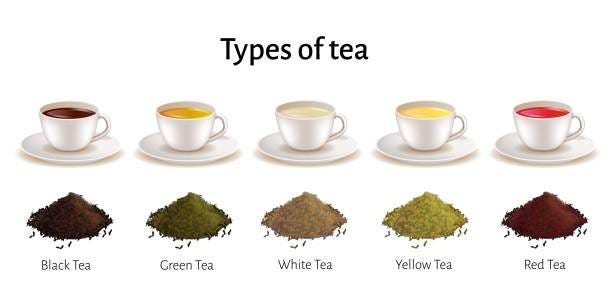Tea is more than just a beverage; it’s a cultural experience enjoyed by millions worldwide. Whether you’re sipping a strong black tea in the morning or a soothing herbal infusion before bed, tea offers endless flavors, aromas, and health benefits. Understanding the different types of tea allows you to explore a wider range of tastes and tailor your tea consumption to your health needs.
In this article, we’ll embark on a journey through the main types of tea, from the robust flavors of black tea to the delicate nuances of white tea, and delve into herbal infusions. We’ll explore their unique characteristics, processing methods, and the reasons why each deserves a place in your cup. Discover how different teas can contribute to your well-being and enhance your daily routine.
The Main Types of Tea
All true teas come from the same plant, Camellia sinensis. The difference lies in how the leaves are processed, which determines the level of oxidation and, consequently, the tea’s flavor profile and properties. From fully oxidized black tea to minimally processed white tea, each type offers a distinct experience.
Let’s explore the five main types of tea derived from Camellia sinensis.
Black Tea: Bold and Robust
Black tea is the most oxidized form of tea, giving it a dark color and strong flavor. It contains the highest caffeine content among teas, making it a great morning pick-me-up. Popular varieties include:
- Assam (India) – Malty and full-bodied
- Darjeeling (India) – Delicate, floral, and muscatel
- Earl Grey (Global) – Infused with bergamot for a citrusy aroma
Black tea is often enjoyed with milk, sugar, or lemon, depending on regional preferences. It’s a versatile tea that can be paired with various foods, from breakfast pastries to savory dishes.
Green Tea: Fresh and Vibrant
Green tea is minimally oxidized, preserving its green color and delicate taste. It’s rich in antioxidants, particularly catechins, which are linked to numerous health benefits. Some famous types include:
- Sencha (Japan) – Grassy, sweet, and umami-rich
- Matcha (Japan) – Powdered tea with a creamy, rich flavor
- Dragon Well (Longjing) (China) – Nutty, smooth, and slightly sweet
Green tea is best brewed at lower temperatures (around 70–80°C) to avoid bitterness. Its fresh and vibrant flavor makes it a popular choice for those seeking a healthy and refreshing beverage.
White Tea: Delicate and Subtle
White tea undergoes the least processing, making it the most delicate and naturally sweet among teas. It is made from young tea buds and leaves, often covered in fine white hairs. Popular varieties include:
- Silver Needle – Light, floral, and sweet
- White Peony – Mild, fruity, and slightly earthy
Due to its minimal processing, white tea retains high levels of antioxidants and is often praised for its skin benefits. It’s a luxurious tea that offers a subtle and refined taste experience.
Oolong Tea: The Perfect Balance
Oolong tea falls between green and black tea in terms of oxidation, offering a diverse range of flavors. Some are light and floral, while others are dark and roasted. Well-known oolong teas include:
- Tieguanyin (China) – Floral, buttery, and smooth
- Da Hong Pao (China) – Dark, roasted, and complex
Oolong is often enjoyed in traditional Chinese tea ceremonies, emphasizing its evolving flavors over multiple infusions. Its complex flavors make it a favorite among tea enthusiasts.
Pu-erh Tea: Aged and Fermented
Pu-erh is a fermented tea from China, known for its deep, earthy flavors and potential digestive benefits. It comes in two types:
- Raw Pu-erh (Sheng) – Aged naturally, with a complex and evolving taste
- Ripe Pu-erh (Shou) – Undergoes accelerated fermentation, resulting in a dark, smooth brew
Pu-erh is often compressed into cakes and can be aged for decades, much like fine wine. Its unique fermentation process gives it a distinct flavor profile that sets it apart from other teas.
Herbal Teas and Tisanes: Caffeine-Free Infusions
Although not technically “tea” (as they don’t come from Camellia sinensis), herbal infusions offer a variety of flavors and health benefits. Some popular ones include:
- Chamomile – Calming, floral, and great for sleep
- Peppermint – Cooling, refreshing, and aids digestion
- Rooibos (South Africa) – Naturally sweet, caffeine-free, and rich in antioxidants
Herbal teas are perfect for relaxation and can be enjoyed hot or iced. They provide a caffeine-free alternative to traditional teas, making them ideal for evening consumption.
Conclusion
From bold black teas to delicate white teas and earthy pu-erh, every type of tea has a unique character and cultural significance. The processing method greatly influences the tea’s flavor, aroma, and health benefits. Exploring these differences can lead to a more nuanced appreciation of tea.
Whether you’re a tea connoisseur or just starting your tea journey, there’s always a new flavor to explore. Each type of tea offers distinct health benefits, from antioxidant boosts to digestive support. So, what’s your cup of tea? Consider exploring different varieties to find your perfect match and enhance your well-being.
